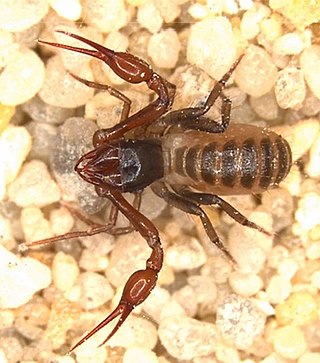
Pseudoscorpions, also known as false scorpions or book scorpions, are small, scorpion-like arachnids belonging to the order Pseudoscorpiones, also known as Pseudoscorpionida or Chelonethida.
Feaella is a genus of pseudoscorpions in the family Feaellidae, first described by Edvard Ellingsen in 1906.
Menthidae is a family of pseudoscorpions, first described by Joseph Conrad Chamberlin in 1930.

Garypinidae is a family of pseudoscorpions, first described by Eugen von Daday in 1889.
Atemnidae is a family of pseudoscorpions, first described by Kyukichi Kishida in 1929.

Anatemnus is a genus of pseudoscorpions.

Hans Henderickx (1961–2016) was a Belgian entomologist specializing in Invertebrates born in Mol, Belgium.
Garypidae is a family of pseudoscorpions, first described by Eugène Simon in 1879.
Ideoroncidae is a family of pseudoscorpions belonging to the order Pseudoscorpiones. Members of the family are known from Asia, Africa, western North America and South America.

Withiidae is a family of pseudoscorpions, first described by Joseph Conrad Chamberlin in 1931.
Austrochthonius is a genus of pseudoscorpions in the family Chthoniidae. It was described in 1929 by American arachnologist Joseph Conrad Chamberlin.

Tyrannochthonius is a genus of pseudoscorpions in the family Chthoniidae. It was described in 1929 by American arachnologist Joseph Conrad Chamberlin.

Pseudotyrannochthonius is a genus of pseudoscorpions in the family Pseudotyrannochthoniidae. It was described in 1930 by Austrian arachnologist Max Beier.
Feaella anderseni is a species of pseudoscorpion in the Feaellidae family. It is endemic to Australia. It was described in 1989 by Australian arachnologist Mark Harvey. The specific epithet anderseni honours Alan Andersen, collector of some of the specimens.
Feaella callani is a species of pseudoscorpion in the Feaellidae family. It is endemic to Australia. It was described in 2016 by Australian arachnologists Mark Harvey, Kym Abrams, Amber Beavis, Mia Hillyer and Joel Huey.
Feaella linetteae is a species of pseudoscorpion in the Feaellidae family. It is endemic to Australia. It was described in 2016 by Australian arachnologists Mark Harvey, Kym Abrams, Amber Beavis, Mia Hillyer and Joel Huey.
Feaella tealei is a species of pseudoscorpion in the Feaellidae family. It is endemic to Australia. It was described in 2016 by Australian arachnologists Mark Harvey, Kym Abrams, Amber Beavis, Mia Hillyer and Joel Huey.
Anysrius is a genus of pseudoscorpions in the Syarinidae family. It is endemic to the Australian state of Tasmania. It was described in 1998 by Australian arachnologist Mark Harvey. The genus name Anysrius is an anagram of its sister genus Syarinus.
Ideoblothrus is a genus of pseudoscorpions in the Syarinidae family. It was described in 1892 by Italian naturalist Luigi Balzan as a subgenus of Ideobisium.







